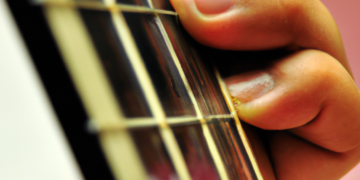The marching euphonium goes back to the early 19th century when it started to gain some popularity among musicians. Brass family instruments were in circulation before that but the euphonium was the first instance when a brass instrument with a valve was introduced to the world.
The euphonium can be best explained in the context of an orchestra where a cello plays the role of a rich and deep contrast to other instruments in the ensemble. The euphonium serves a similar purpose in a band where it produces a sound that is rich and deep in its output. It is mostly used in marching bands and is therefore famously referred to as marching euphonium.
The baritone is an instrument that is thought of whenever euphoniums are mentioned as they are quite similar. However, euphoniums are a bit more advanced than baritones as it requires extensive mastery over the equipment to play it effectively. Baritones are recommended for beginners and players can move from baritones to euphoniums following a gradual progression stage.
Baritone vs Euphoniums
The foremost difference that players can think of when describing baritone and euphoniums is the difference in structure. Baritones are more of cylindrical objects which are followed by a flared out bell. The cylindrical structure of the bore aids players to maintain a specific tone which is helpful for a beginner.
On the other hand, the bore of a euphonium is rather conical in shape. It means that the bore gradually flares out as it gets longer and ends with a flared out bell. Because of this, euphonium has a darker output than the baritone. Also, it is much harder for players to maintain a full tone while playing the euphonium.
The Place Of A Marching Euphonium In A Band
Euphonium is also widely known as marching euphonium as it is in marching setups that you can usually see them being used. Marching bands include a plethora of wind instruments along with the euphonium among which are the french horn, alto horns, trumpets and trombones. The euphonium provides a dark and rich backdrop to other dynamic instruments in the band which creates a contrast that really brings out the tune more robustly.
Number Of Valves In A Marching Euphonium
Euphoniums can be found in two varieties. You can either go for a four valved version or a three valved one based on your preferences. Professionals usually go for the four-valve version as it has its advantages.
The extra valve provides a bit more manoeuvrability to the output which can come in handy for people who are well accustomed to the instrument. It enhances the intonation and the low range of the instrument is increased. The four-valve setup can be found in a useful variation of 3+1. In this setup, 3 valves are placed together while the fourth valve is located on the left side which makes it easier for players to get a proper hold of the instrument.
Compensating Euphoniums And Non-Compensating Euphoniums
Marching euphoniums can be further divided into two categories based on the role they play. You can either go for a compensating euphonium or you can go for a non-compensating euphonium. A compensating euphonium is called so because it is useful when you are looking to compensate for the sharp low registers that are usually a tendency of a euphonium. This is done by providing a bit of extra tubing to the instrument.
The compensation technique requires a bit of expertise as it includes the use of the valves in a systematic manner to lower the pitch to the point that the low registers are in tune. A non-compensating euphonium does not have the extra tubing that compensating euphoniums are provided with. Players have to depend on manual manoeuvring to bring the pitch down to make the low registers closer to the tune.
Mouthpiece Shanks For Marching Euphoniums
The shank size refers to the taper as well as the diameter of the mouthpiece’s end that is lodged into the instrument. It was something that was not looked at before but these days people have come to realize the fact that mouthpieces need to be in sync with the instrument in hand. This allows the instrument to be much more optimized in terms of the control as well as the output. Euphonium mouthpiece receivers have three categories.
- Small Shanks
These mouthpieces are found in small tenor trombones as well. As the name suggests, they are the smallest variety of mouthpieces that are available for euphoniums.
- Large Shanks
Large shanks are found in bass and large tenor trombones. This is the biggest mouthpiece available for euphoniums.
- Medium Shanks
This shank falls in between both the sizes mentioned above. These are mostly found in euphoniums that are manufactured in Europe and are therefore also called European shanks.
Finishes
Marching euphoniums mostly have two variations of finishes. The first one is the silver-plated finish and the second is the lacquer finish. However, finishes in euphoniums don’t simply serve the purpose of making the instrument palatable for the eye but rather also play a role in how the instrument performs.
The silver-plated finish is the most preferred one and is opted for by both beginners and professionals alike. It contributes to a brighter sound from the instrument and is also more responsive than the ones with the lacquer finish.
We have provided sufficient information regarding the basics as well specifics to distinguish a marching euphonium with ease. We are certain that you will be more aware of what goes into eyeing out a euphonium that is up to par with what you are specifically looking for. Keep in mind that it is essential to consider the age as well as the level of expertise of a player. We would recommend an opinion from a seasoned player on top of the information we have provided to make the best choice possible.

